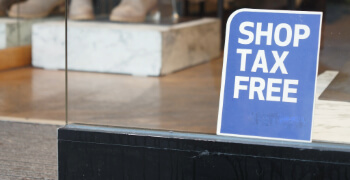Wisconsin provides sales tax rebate for dependent children, sales tax holiday in 2018
A larger than expected budget surplus inspired Wisconsin Governor Scott Walker to call for tax relief for Wisconsinites. For months he’s been promoting a summer sales tax holiday and a sales tax rebate for claimants with dependent children, and he’s succeeded.
Senate Bill 798, signed into law on April 17, 2018, provides a $100 sales tax rebate to a claimant for each qualified dependent child, and creates a one-time sales tax holiday for qualifying clothing, computers, and school supplies.
Dependent children sales and use tax rebate
The $100 sales and use tax rebate per qualified dependent child is available to anyone who is a resident of Wisconsin and has a dependent child. To qualify, a child must be:
- Under the age of 18 as of December 31, 2017
- The claimant’s dependent
- A citizen of the United States
- A resident of Wisconsin on December 31, 2017
Gov. Walker exercised the partial veto to this section. He explains in his veto message: “I object to the definition of a qualified child excluding children under the care of grandparents and other relatives. … The bill’s language … would exclude cases where other family members are raising a child who lost his or her parents to death, incapacitation or incarceration, or other factors. This would exclude grandparents, aunts, uncles and other relatives from being eligible for claiming the rebate for children in their care. This partial veto corrects an inadvertent error and ensures at least 75,000 children are eligible, as was the original intent of this proposal.”
To claim the rebate, eligible claimants must submit an online application to the Wisconsin Department of Revenue between May 15 and July 2, 2018 (the actual webpage will be announced prior to May 15). They may be required to furnish proof of eligibility to the department. According to SB 798, “An individual who is a full-year resident, nonresident, or part-year resident and who has a qualified child is eligible to receive a rebate,” provided they can furnish proof of paying at least $100 in nonbusiness Wisconsin sales or use taxes in 2017 per qualified child.
Only one person may claim the rebate of a qualified dependent child. However, after a rebate has been issued but before it’s been cashed, the spouse of a married claimant may request a separate check for 50 percent of the joint rebate.
According to a gubernatorial press release, “Those who claim the rebate will receive the money before school starts this fall and have the option to receive it through a check in the mail or direct deposit.” These must be cashed by December 31, 2018, or the right to the rebate lapses.
August sales tax holiday
As introduced, SB 798 called for a two-day sales tax holiday, August 4–5, 2018. However, Gov. Walker issued a partial veto to the legislation, expanding the tax-free period to five days, August 1–5. He explains: “I object to limiting the sales tax holiday to only two days, which may deny hardworking taxpayers with children the chance to take advantage of this sales tax holiday. … By extending the period of the sales tax holiday to these five days instead of two days, more parents and students will have the flexibility to save on critical purchases during the back-to-school season.”
Exempt purchases
During the tax holiday, a wide array of clothing, computers, computer supplies, and school supplies will be exempt from state and applicable local sales tax. The exemption applies to the following:
- Clothing with a sales price of no more than $75 per item
- Computers, laptops, or tablets (purchased for personal use) with a sales price of no more than $750 per item
- School computer supplies with a sales price of no more than $250
- School supplies with a sales price of no more than $75 per item
Taxable purchases
The exemption does not apply to numerous items, including:
- Clothing accessories or equipment (e.g., belt buckles, briefcases, cosmetics, costume masks sold separately, hair notions, handbags, and jewelry)
- Cell phones
- Patches, emblems, and sewing equipment
- Protective equipment (e.g., breathing masks, helmets, safety glasses, and goggles)
- School art supplies (e.g., clay and glazes; paints; sketch and drawing pads
- School instructional materials (e.g., reference books, maps, and globes; textbooks; and workbooks)
- Sport or recreational equipment (e.g., athletic shoes, mouth guards, and wetsuits)
Delivery charges
Delivery charges are considered part of the sales price of a transaction. If all the property in a shipment is eligible for the sales tax exemption and the sales price for each item is within the price threshold, the shipment is considered a sale of eligible property. Consequently, sales tax doesn’t apply to any shipping, handling, or delivery charges that make the sale exceed the sales threshold.
However, if a shipment includes both qualifying (exempt) and non-qualifying (taxable) items, tax must be applied to a percentage of the delivery, handling, and shipping charges. The percentage should be determined by using one of the following methods:
- A percentage based on the total sales price of the taxable property compared to the total sales price of all property in the shipment
- A percentage based on the total weight of the taxable property compared to the total weight of all property in the shipment
Layaways
Qualifying items purchased on layaway are eligible for the exemption provided final payment is made and the purchaser receives the property during the tax-free period. The exemption also applies if the purchaser selects and the retailer accepts the order for the item during the layaway period, for immediate delivery upon full payment, even if delivery is made after the sales tax holiday.
Online sales
Registered sellers based in other states are required to comply with the rules of the sales tax holiday. For those based in different time zones, it is the time zone of the seller’s location that determines the authorized period for the exemption. For example, if a Wisconsin resident purchases a qualifying item from a California-based retailer at 1 a.m., August 1, when it’s 11 p.m., July 31, at the location of the California seller, tax must be applied to the sale.
Rain checks
Eligible property purchased during the sales tax holiday with a rain check qualifies for the exemption regardless of when the rain check was issued. However, items purchased after the sales tax holiday with a rain check issued during it don’t qualify for the exemption.
For additional details, see the text of Senate Bill 798.
Sales tax holidays complicate sales tax compliance
Tax-free periods are generally popular among consumers but can complicate sales and use tax compliance for retailers. For example, point-of-sale systems must be changed to account for the exemptions, and then changed back; staff must be trained to understand how tax applies to delivery charges, layaway sales, rainchecks, and more.
The fact that more than a dozen states provide more than 20 sales tax holidays throughout the year further complicates compliance. Retailers that sell qualifying items into multiple states with tax-free periods must account for different sales tax holiday dates, rules, and thresholds.

Avalara Tax Changes 2026 is here
The 10th edition of our annual report engagingly breaks down key policies related to sales tax, tariffs, and VAT.
Stay up to date
Sign up for our free newsletter and stay up to date with the latest tax news.















